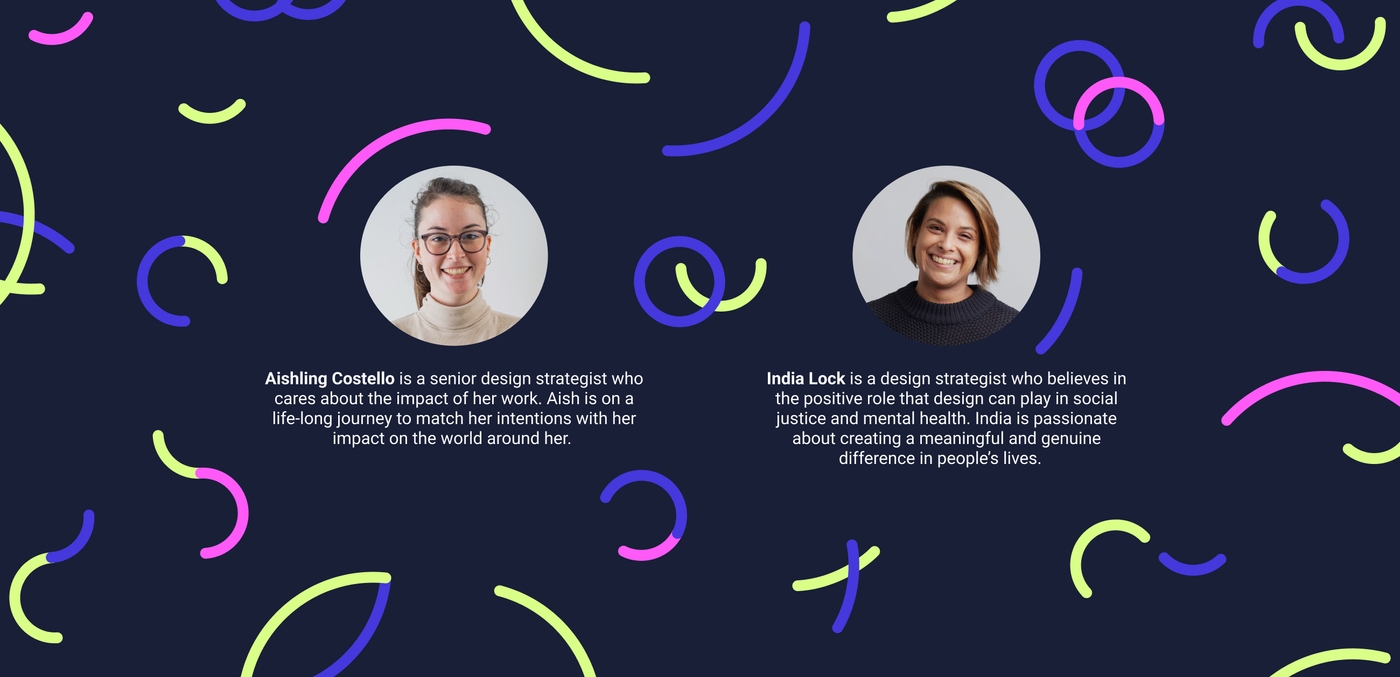At Portable, we seek out areas of policy failure and systemic change. Our clients are often service providers working with people who have lived experience of highly challenging and adverse events.
As human-centred designers, we invite people who are impacted the most by systemic challenges into our work as empowered contributors, participants, fellow makers and co-creators, co-designers or co-producers.
While this approach is inclusive and steeped in great intentions, we have noticed that practising human-centred design (HCD) with people who have lived experience of trauma and more specifically, interpersonal trauma, does not always create a safe and supportive environment for people with lived experience to thrive in.
This article will look at some ways that we consider a trauma responsive approach to our ethical HCD work, so that we can better respond to the needs of people with lived experience of interpersonal trauma. In it you’ll find considerations we reflect on as well as information we have learned through listening to and learning from people with lived experience of trauma.
Our hope is that this article will inspire your own reflections and questions to percolate through. If you are inspired to ask questions; start conversations! Get the community talking. At Portable, we learn through reflecting, sharing and doing. We hope you do too.
As people we are all wired to seek out social connection, to build relationships with others and to feel like we are part of a group. But for people with lived experience of interpersonal trauma, relationships may be something to be wary of. When someone experiences interpersonal trauma in the context of a relationship with another person, whether that’s with a family member, friend or a stranger, they learn to protect themselves so that they can stay safe in the future. This can lead to people avoiding relationships and having difficulty trusting others. The experience of interpersonal trauma creates an internal tension; between wanting to connect with others, but also shying away from connection because it feels unsafe.
Let’s take a look at two scenarios that illustrate the difference a trauma responsive design approach can have.
Scenario 1 : Lived experience research interview
In our first scenario, a person with lived experience of interpersonal trauma has agreed to participate in a research interview.
During the interview, the designer meets and greets their participant and demonstrates interest and curiosity in the person and their experiences. The designer invites the person to share what has happened to them, and asks probing follow-up questions to go deeper into the person’s needs and challenges.
The interview ends, the participant leaves and the designer continues to run their remaining series of interviews.
Scenario 2 : Lived experience research interview
Ahead of the interview, the designer and participant meet for a short phone call. During the pre-interview call, the designer:
- Shares context about the project, detail about the types of questions and topics that will be discussed.
- Describes how data is managed and stored.
- Describes how people are deidentified throughout the research.
- Provides clear pathways for participants if they want to withdraw from the research.
- Provides meaningful choices to participants so they are empowered to co-create a research interview environment that meets shared expectations for meaningful participation
- Provides meaningful choices to participants so that they have a comfortable environment to share, learn, reflect and rest. This might look like providing different channels of communication for the interview; over zoom, in-person or a phone call.
After each piece of information, the designer checks-in with the research participant to see if they have any questions.
At the start of the interview the designer:
- Greets the participant and welcomes them into the space using preferred pronouns and any identifiers the participant prefers.
- Creates a space that feels open and non-judgemental.
- Checks-in with the participant after each key piece of information in case they have any questions or concerns.
- Reminds the room of the project context, what interview topics will be covered, why these are being covered and again checks-in with the participant to gather informed consent to continue the research and to record (if required).
The designer demonstrates interest and curiosity in the person and their experiences. They invite the person to share what has happened to them, and check-in with the person before digging deeper into any particular topic or question. Wellbeing supports (such as on-call professional counselling) have been set up in advance and the participant is aware of how and when they can access these supports.

In both of these scenarios, the designer is acting with the best of intentions and believes they are taking the right steps to best support their research participant.
The difference is that in scenario two, the designer is slowing down the process so they can provide more context, check-in, seek informed consent to continue or pause, and offer meaningful choices about next steps. Slowing down increases the opportunity for both the designer and participant to self-regulate. (Self-regulation is the ability to navigate and manage your thoughts or emotional response to events happening around you). This approach meets people where they are at and creates space for people to participate meaningfully.
The first scenario may cause some unintentional harm for the participant and designer. There is not a lot of time for checking-in, slowing down and coming back to feeling balanced. And both participants may feel dysregulated (unbalanced and reactionary to events around them) before, during and/or after the interview.
Slowing down the design process encourages us to pause and check-in. This means the flow of conversation pauses and the participant has more time and space to process their cognitive and emotional responses in a healthy and balanced way.
Sometimes when we share a story from our past, especially one connected with an emotional response, we get carried away with our words. As we fall out of the window of tolerance and into hyper- or hypo-arousal, it can feel like we’re running downhill or come to a complete and frozen stop. In our previous article, we mentioned Rachael Dietkus’ integrated definition of trauma in a design context as something that happens ‘too fast’. A key consideration in our work as trauma responsive designers is to look at moments where we can slow down the pace of our work and encourage self-regulation to happen through agreed activities.
It’s also important to recognise that in the above examples, while both of these approaches would likely be fine for someone who didn’t have lived experience of trauma, as humans we all appreciate having predictability, certainty and knowing what the boundaries are. Approaching an interview the way the designer did in scenario two is beneficial for both people with lived experience of trauma as well as people who haven’t had traumatising experiences.

Three takeaways for you to reflect on
Reflecting on our previous scenarios, here are a few tips to help you build your trauma informed practice and become a trauma responsive designer:
1. Consider your pace.
Consider ways you can slow down the pace of your project at key moments so that everyone involved has the time and space for self-regulation and agency over their own informed consent. As we can see in scenario two, slowing down gives designers the opportunity to provide context, seek informed consent, offer meaningful options, make the process predictable and create opportunities for self-regulation.
2. Regularly reflect.
Reflective / reflexive practice has become part of our weekly rituals. Through reflection, we’ve learned how to do better and create scenarios like the ones you see above. Learning from our past selves to do better in the future helps us embody our practice. Taking a compassionate approach to reflection isn’t always easy, but is important for our own wellbeing. Reflect with a team you feel safe to reflect with. This might look like a nature walk in the morning, audio journaling your reflections or a 30 minute team reflection session on a Friday afternoon.
3. Develop a learner mindset.
In our work, a learner mindset helps us create environments where people can feel safe to offer us feedback. A learner mindset both safeguards us to hear feedback (as we are seeking ways to learn and grow through action) and shows others we want to hear their feedback. We might practise a learner mindset by being open and transparent about the learning outcomes of our project and inviting participants to ask questions / reflect on those outcomes with us during our research.
We could not continue our research and growth as trauma informed and responsive designers without the support of people who have joined us along the way. We acknowledge that lived experience is a form of expertise. And we want to thank everyone who has shared their expertise with us, paused to offer us feedback on our approach and has helped us learn and grow.
Interested in our work?
If you would like to learn more about our research or would like to contribute on this project, we encourage you to follow the link below to reach out to our team.
